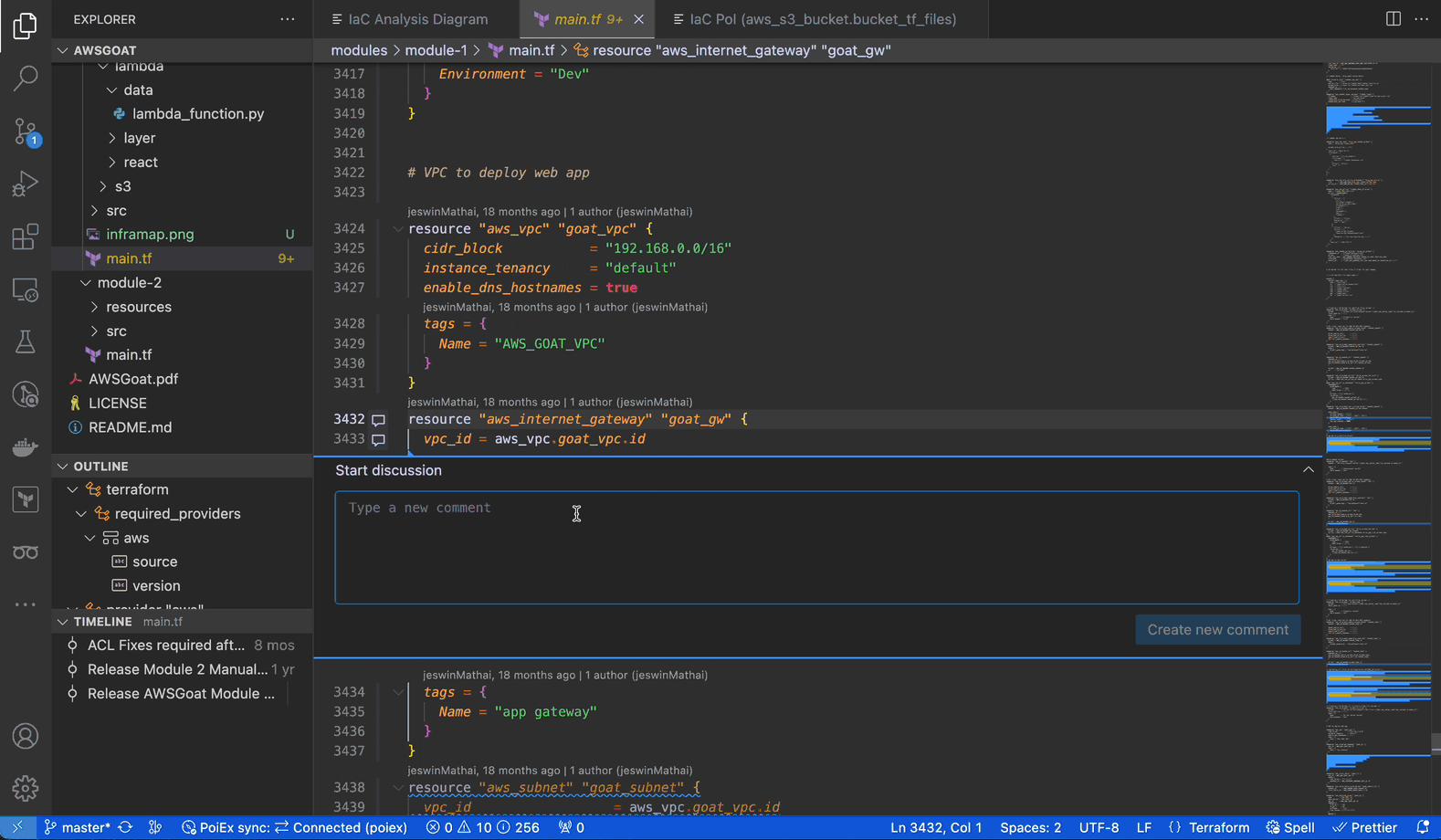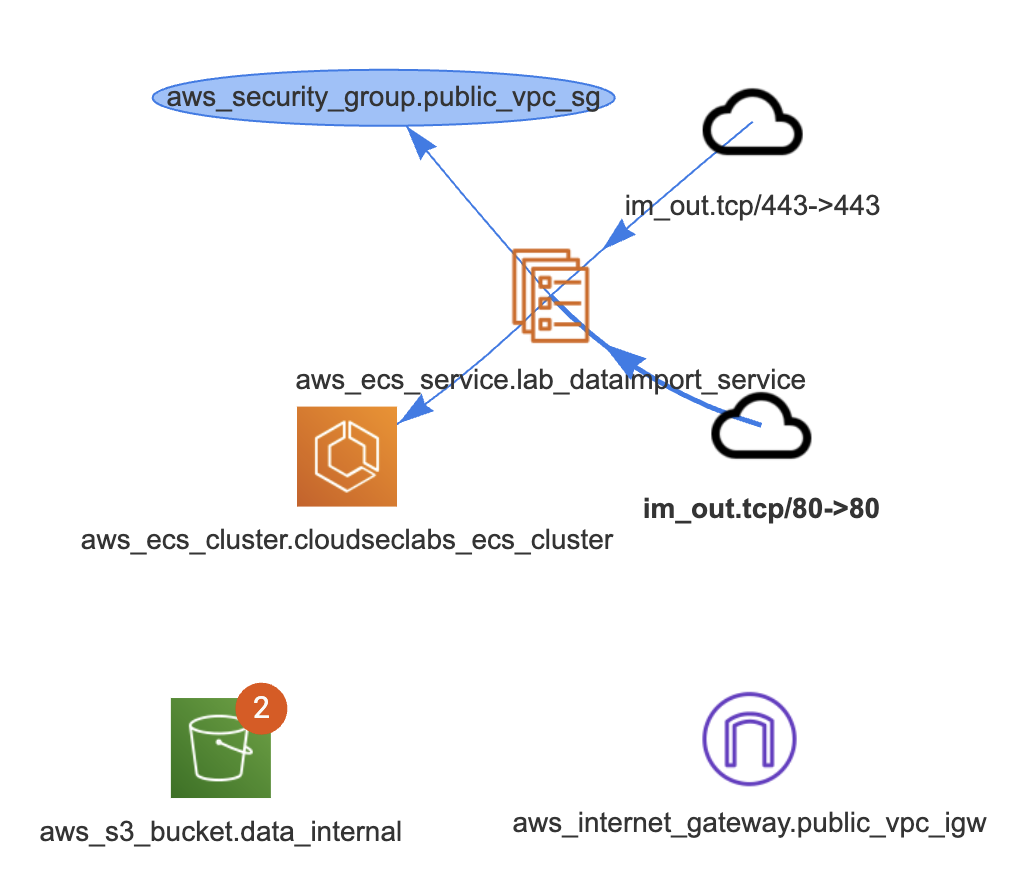Introducing PoIEx - Points Of Intersection Explorer
30 Jan 2024 - Posted by Francesco Lacerenza, Michele LizzitWe are releasing a previously internal-only tool to improve Infrastructure as Code (IaC) analysis and enhance Visual Studio Code allowing real-time collaboration during manual code analysis activities. We’re excited to announce that PoIEx is now available on Github.

Nowadays, cloud-oriented solutions are no longer a buzzword, cloud providers offer ever more intelligent infrastructure services, handling features ranging from simple object storage to complex tasks such as user authentication and identity access management. With the growing complexity of cloud infrastructure, the interactions between application logic and infrastructure begin to play a critical role in ensuring application security.
With many recent high-profile incidents resulting from an insecure combination of web and cloud related technologies, focusing on the points where they meet is crucial to discover new bugs.
PoIEx is a new Visual Studio Code extension that aids testers in analyzing interactions between code and infrastructure by enumerating, plotting and connecting the so called Points of Intersection.
Introducing the Point of Intersection - A novel approach to IaC-App analysis
A Point of Intersection (PoI) marks where the code interacts with the underlying cloud infrastructure, revealing connections between the implemented logic and the Infrastructure as Code (IaC) defining the configuration of the involved cloud services.
Enumerating PoIs is crucial while performing manual reviews to find hybrid cloud-web vulnerabilities exploitable by tricking the application logic into abusing the underlying infrastructure service.
PoIEx identifies and visualizes PoIs, allowing security engineers and cloud security specialists to better understand and identify security vulnerabilities in cloud-oriented applications.
PoIEx: Enhancing VSCode to support Code Reviews
PoIEx scans the application code and the IaC definition at the same time, leveraging Semgrep and custom rulesets, finds code sections that are IaC-relevant, and visualizes results in a nice and user-friendly view. Engineers can navigate the infrastructure diagram and quickly jump to the relevant application code sections where the selected infrastructure resource is used.

If you use VSCode to audit large codebases you may have noticed that all of its features are tailored towards the needs of the developer community. At Doyensec we have solved this issue with PoiEx. The extension enhances VSCode with all the features required to efficiently perform code reviews, such as advanced collaboration capabilities, notes taking using the VS Code Comments API and integration with Semgrep, allowing it to be used also as a standalone Semgrep and project collaboration tool, without any of its IaC-specific features.
At Doyensec, we use PoIEx as a collaboration and review-enhancement tool.
Below we introduce the non-IaC related features, along with our use cases.
✍️ Notes Taking As Organized Threads
PoIEx adds commenting capabilities to VSCode. Users can place sticky notes to any code locations without editing the codebase.
At Doyensec, we usually organize threads with a naming convention involving prefixes like: VULN, LEAD, TODO, etc. We have found that placing shared annotations directly on the codebase greatly improves efficiency when multiple testers are working on the same project.

In collaboration mode, members receive an interactive notification for every reply or thread creation, enabling real-time sync among the reviewers about leads, notes and vulnerabilities.
👨💻 PoIEx as a standalone Semgrep extension for VSCode
PoIEx works also as a standalone VSCode extension for Semgrep. PoIEx allows the user to scan the entire workspace and presents Semgrep findings nicely in the VSCode “Problems” tab.
Moreover, by right-clicking the issue, it is possible to apply a flag and update its status as: ❌ false positive,🔥 Hot or ` ✅ resolved`. The status is synced in collaboration mode to avoid duplicating checks.
The extension settings allow the user to setup custom arguments for Semgrep. As an example we currently use --config /path/to/your/custom-semgrep-rules --metrics off to turn off metrics and set it use our custom rules.
The scan can be started from the extension side-menu and the results are explorable from the VS Code problems sub-menu. Users can use the built-in search functionality in a smart way to find interesting leads.

🎯 Project-oriented Design
PoIEx allows for real-time synchronization of findings and comments with other users. When using collaboration features, a MongoDB instance needs to be shared across all collaborators of the team.
The project-oriented design allows us to map projects and share an encryption key with the testers assigned to a specific activity. This design feature ensures that sensitive data is encrypted at rest.
Comments and scan results are synced to a MongoDB instance, while the codebase remains local and each reviewer must share the same version.
A Real-World Analysis Example - Solving Tidbits Ep.1 With PoIEx
In case you are not familiar with it, CloudSec Tidbits is our blogpost series showcasing interesting real-world bugs found by Doyensec during cloud security testing activities. The blog posts & labs can be found in this repository.
Episode 1 describes a specific type of vulnerability affecting the application logic when user-input is used to instantiate the AWS SDK client. Without proper checks, the user could be able to force the app to use the instance role, instead of external credentials, to interact with the AWS service. Depending on the functionality, such a flaw could allow unwanted actions against the internal infrastructure.
Below, we are covering the issue identification in a code review, as soon as the codebase is opened and explored with PoIEx.
Once downloaded and opened in VS Code, examine the codebase for Lab 1, by using PoIEx to run Semgrep and show the infrastructure diagram by selecting the main.tf file. The result should be similar to the following one.

The notifications on aws_s3_bucket.data_internal represent two findings for that bucket.
By clicking on it, a new tab is opened to visualize them.

The first group contains PoIs and Semgrep findings, while the second group contains the IaC definition of the clicked entity.
In that case we see that there is an S3 PoI in app/web.go:52. Once clicked, we are redirected at the GetListObjects function defined at web.go#L50. While it is just listing the files in an S3 bucket, both the SDK client config and bucket name are passed as parameters in its signature.
A quick search for its usages will show the vulnerable code
//*aws config initialization
aws_config := &aws.Config{}
if len(imptdata.AccessKey) == 0 || len(imptdata.SecretKey) == 0 {
fmt.Println("Using nil value for Credentials")
aws_config.Credentials = nil
} else {
fmt.Println("Using NewStaticCredentials")
aws_config.Credentials = credentials.NewStaticCredentials(imptdata.AccessKey, imptdata.SecretKey, "")
}
//list of all objects
allObjects, err := GetListObjects(session_init, aws_config, *aws.String(imptdata.BucketName))
If the aws_config.Credentials is set to nilbecause of a missing key/secret in the input, the credentials provider chain will be used and the instance’s IAM role is assumed. In that case, the automatically retrieved credentials have full access to internal S3 buckets. Quickly jump to the TF definition from the S3 bucket results tab.
After the listing, the DownloadContent function is executed (at web.go line 129 ) and the bucket’s contents are exposed to the user.
At this point, the reviewer knows that if the function is called with an empty AWS Key or Secret, the import data functionality will end up downloading the content with the instance’s role, hence allowing internal bucket names as input.
To exploit the vulnerability, hit the endpoint /importData with empty credentials and the name of an internal bucket (solution at the beginning of Cloudsec Tidbits episode 2).
Stay Tuned!
This project was made with love on the Doyensec Research Island by Michele Lizzit for his master thesis at ETH Zurich under the mentoring of Francesco Lacerenza.
Check out PoIEx! Install the last release from GitHub and contribute with a star, bug reports or suggestions.

